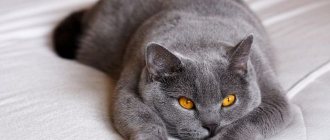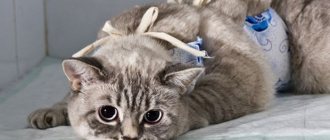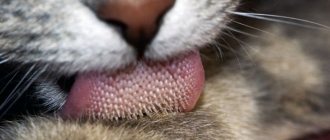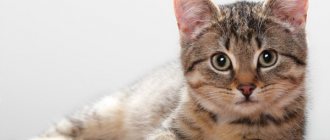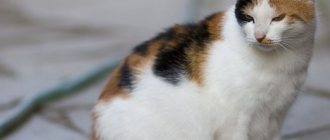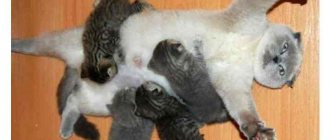(adsbygoogle = window.adsbygoogle || []).push({});
Cat birth is a crucial moment in the life of a furry pet. Therefore, during this period of life, cats are the cleanest: they lick themselves more often than usual. As a rule, this is the area of the abdomen and genitals. From a behavioral point of view, the four-legged friend expresses anxiety; cats may exhibit aggression or simply irritability. At the same time, the pet begins to look for secluded corners in the house, considering every suitable place as a cozy nest for cat birth. Such places can be closets, closets, dark corners behind a sofa or bed, and even a permanent sleeping place for a cat , etc.
It is at this moment that it is better to offer the cat a low box, a wicker basket or a box as a nest, so that it is convenient to give birth to offspring. A few days will be enough for your pet to get used to the new amenities. However, it may happen that the expectant mother is simply in the box, but gives birth in a completely different place. In this case, it is better to transfer the newly-made offspring to a box. The main sign of labor in a cat is a drop in rectal temperature. Starting from the 61st day of a cat’s pregnancy, it is better to take this indicator under control. Cat labor usually begins 12 to 24 hours after the temperature drops from 38.6 degrees to 37.5 degrees. But there are also situations when the temperature cannot be used to determine the moment of birth.
An alarming sign during childbirth - the cat does not have an afterbirth, what should I do?
When giving birth independently, your pet often experiences complications in the form of retained placenta.
If the cat does not have an afterbirth, what should you do in this situation? This issue worries not only beginners, but also experienced breeders, as it poses a threat to the health and sometimes the life of the animal. In order to competently provide assistance during childbirth, in time to suspect the retention of the placenta in the uterus, it is necessary to understand what a cat’s placenta is. Normally, the birth act in all animals ends with the separation of the membranes, the so-called afterbirth (placenta, baby's place). During intrauterine development, the placental membranes provide a physiological connection between the mother’s body and the developing fetus. With their help, the supply of nutrients and oxygen occurs, as well as the utilization of metabolic products of growing fruits.
The afterbirth came out with the kitten
During childbirth without complications, after the kitten is born, its baby's place comes out either after it or after a few minutes. Each newborn has its own placenta, so the number of kittens born must correspond to the number of membranes released. Owners often wonder how long it takes for a cat to lose its placenta. Veterinary experts consider it normal for the membranes to rupture within 3 hours after birth.
There are several reasons why a child’s place is detained:
- uterine atony (insufficient contractile function);
- premature cervical closure;
- inflammatory processes of the reproductive system (endometrium and placenta);
- accumulation of fluid in the amniotic membranes;
- stretching of the uterine tissue during the birth of large or large numbers of fetuses.
Predisposing factors are:
- overweight (obesity);
- lack of physical activity during pregnancy;
To prevent placenta retention, the owner of a furry pet should pay attention to keeping the cat during pregnancy. Physical inactivity, weight problems, lack of complete proteins, vitamins and minerals in the diet can lead to the development of complications in the form of delayed childbirth.
The owner of the animal must understand the threat this pathology of the birth process poses. Retention of the placenta in the birth canal can be complete or partial. If the child's seat has not separated at all, then we are talking about complete detention. If the membranes do not come out completely, then this pathology is called partial retention of the placenta. In both cases, there is a threat of inflammation.
The open birth canal quickly becomes infected with microbes. In this case, putrefactive inflammation of the uterus occurs, since the cervix is not yet closed. An inflamed mother's womb is a good breeding ground for the development of bacteria, which easily penetrate the bloodstream and spread throughout the body, causing septicemia (blood poisoning). The animal becomes severely intoxicated.
Untimely assistance can lead not only to the loss of the ability to reproduce, but also to death. Therefore, owners must be present during the birth and monitor the expulsion of the pet’s placenta.
When helping with childbirth, the owner should pay attention to how many afterbirths the cat has. To do this, it is necessary to count the kittens and the delivered placentas. Their number should be equal. The baby's place emerges from the birth canal after each kitten is born.
It's normal for a cat to eat the afterbirth.
Quite often, cats eat placenta. This phenomenon is instinctive in nature. In the wild, the female must keep her nest clean to prevent predators and scavengers from finding it. In addition, childbirth requires a lot of energy expenditure from a cat and physically exhausts the animal. Under natural conditions, the mother cannot immediately leave the nest and look for food, so eating the placenta is vital.
Domestic beauties often act by analogy with their wild ancestors. Therefore, the owner must ensure that the cat does not eat the afterbirth. In cases where there is no control over the animal, diagnosing retained placenta will be difficult. Eating the placenta itself is safe for the cat. Whether or not to allow the membranes to be eaten is up to each owner.
There is no consensus among breeders on the appropriateness of this phenomenon. Some believe that in this way the cat stimulates the contractile work of the uterus, and this facilitates the passage of subsequent membranes. Other breeders are categorically against this phenomenon, believing that there is no benefit in it. In any case, your pet should not be allowed to eat more than two placentas to avoid digestive problems (diarrhea, vomiting).
It is also important for the owner to know when the cat’s placenta comes out normally. This process is individual for each animal. In some cats, the passage of the placenta is observed literally after the birth of the kitten, in others - after half an hour or an hour. However, if more than 3 hours have passed and the membranes have not come out, you should immediately contact a veterinarian.
In the Pets section, to the question: After giving birth to a kitten, the cat did not come out with an afterbirth! Is it possible to help her manually? asked by the author Xanna the best answer is this how? great vet... You just have to wait a little and it will come out on its own.
Answer from Yergeevna[guru]21 CENTURY! There is a veterinarian! Answer from Vladimir Senin [guru] Oxytocin 0.7 ml into the muscle of the hind paw Answer from Valery Kras [active] It’s not possible, but it’s necessary, otherwise it can lead to the death of the animal. Pull and pull it out yourself. Make sure that the number of afterbirths corresponds to the number of kittens. If you can’t handle it yourself: it’s scary, disgusting, or you have no experience, then call a veterinarian Answer from Elena Chetverikova [guru]Are you sure that he is not higher? Perhaps the cat just ate it, this is the most common occurrence, and you might simply not notice it. If the cat is still giving birth, then you should not do anything yet, wait. Kittens appear in a sequence of 10-20 minutes. If you still Answer from Vladimir Ladygin[newbie]I am the owner of the Exotic Pride cattery, I deal with Bengal cats. I ran into a problem: the cat had two afterbirths after giving birth.
I'll tell everyone THERE IS A WAY!! link
In the Pets section, to the question: After giving birth to a kitten, the cat did not come out with an afterbirth! Is it possible to help her manually? asked by the author Xanna the best answer is this how? great vet... You just need to wait a little and it will come out on its own.
Answer from Yergeevna[guru]21 CENTURY! There is a veterinarian! Answer from Vladimir Senin [guru] Oxytocin 0.7 ml into the muscle of the hind paw Answer from Valery Kras [active] It’s not possible, but it’s necessary, otherwise it can lead to the death of the animal. Pull and pull it out yourself. Make sure that the number of afterbirths corresponds to the number of kittens.
If you can’t handle it yourself: it’s scary, disgusting, or you have no experience, then call a veterinarian Answer from Elena Chetverikova [guru]Are you sure that he is not higher? Perhaps the cat just ate it, this is the most common occurrence, and you might simply not notice it. If the cat is still giving birth, then you should not do anything yet, wait.
Why is it dangerous?
For an animal, such a pathology can result in infection entering the bloodstream.
Detention of the birth place can be partial or complete. If we talk about the latter, the afterbirth does not separate completely. A partial delay is observed when the shells do not come out completely.
Both of these conditions are fraught with the rapid onset of inflammatory processes, since the open birth canal infects pathogenic microorganisms. As a result, purulent inflammation of the uterus is often observed. Pathogenic bacteria enter the bloodstream, spreading throughout the body and causing blood poisoning.
If timely assistance is not provided to your pet, the animal may not only become infertile, but also die.
Childbirth in a cat (guide) | Kennel of red Maine Coons "Golden Lion"
Childbirth in a cat is a complex and often quite traumatic process. This article is written for beginners, those who, perhaps for the first time, without the help of a veterinarian, are going to give birth to a cat. Without knowing the basic rules, it is very easy to lose both kittens and the giving birth cat itself. Therefore, it is so important to prepare in advance for this exciting process!
We invite you to read: What nipples look like on a pregnant cat: photos and videos
— Birth place (a box with a heating pad or, better yet, a heating pad at the bottom if it’s cold outside.)
-Diapers (disposable paper) and sterile gauze wipes. Several syringes for 1-2 ml and diabetic ones. -Gamavit (veterinary preparation) - injected into the withers (dose for an average cat -0.5 ml): - on the day of fertilization - for relief childbirth and prevention of postpartum complications - 3 days before birth (that is, on the 62nd day of pregnancy) and during childbirth. To prevent early mortality, Gamavit is administered to newborns on days 1, 3 and 5 or 7 of life at a dose of 0.1 ml/kg.
—Oxytocin ampoule (sold in both veterinary and human pharmacies) Oxytocin is available in different dosages. Or 10 units (that is, 1 ml - 10 units), The maximum dose for cats for the entire labor is 3 units!!! Therefore, you can inject with a total dosage of 10 units - 0.3 ml !!! But they inject it only with an open uterus! Otherwise, contractions that occur while the cervix is closed will cause complete rupture of the uterus!!! If labor is clearly weak - the cat has no contractions or they are weak, the cat is screaming, the kitten is stuck - inject 0.1 ml of oxytocin into the cat's hind paw. You can inject only with a break of at least 45 minutes. This is a last resort. It should not be injected if the cat simply takes long (more than 2-3 hours) quiet breaks between kittens, especially if there is a large litter, then often after 5-6 kittens there may be breaks during which the fetus simply moves along the uterine horn closer to the exit, harsh stimulation at this moment can be dangerous because the placenta may pass prematurely and the fetus will “suffocate” without starting to breathe, i.e. While still in the birth canal, the uterus can also be overstrained and labor activity will stop altogether, and there is also a danger of torsion of the horns and rupture of the uterus.
After the end of labor (especially if not all the placenta has come out), you can inject another 0.1-0.2 ml to cleanse and contract the uterus.
-Travmatin (vet.preparation) is a complex homeopathic medicine that anesthetizes the birth process, regulates the strength of contractions and pushing, prevents postpartum complications, in case of damage, ruptures of the external genitalia, promotes their rapid healing and prevents the development of the inflammatory process.
It is best to solder it (there is no urgent need to make extra holes in a giving birth cat, especially since not all cats tolerate injections calmly). Dose - dilute with boiled or bottled water in a ratio of 1:3 and solder after contractions begin (it is convenient to dilute directly in the syringe and then solder by removing the needle).
• The cat breathes “like a dog”, i.e. with her mouth open, her tongue sticking out as if she was hot • The cat behaves restlessly, often gets in and out of the box so that the kittens cannot really latch onto it • The cat throws some of the kittens out of the box • The cat grabs the kittens (often not at all carefully) and drags them with places to place with increased agitation, refusal to eat, as well as refusal to feed kittens, and in severe cases, a convulsive state (excessive drooling, incoordination of movements, convulsive twitching)
As the condition worsens, the cat falls on its side, convulsions develop, the temperature rises sharply, and the level of calcium in the blood decreases, which leads to the rapid death of the animal). Calcium gluconate must be diluted with saline solution in a ratio of 1:1 (i.e. 2 ml of calcium 2 ml of saline solution), since injection without dilution causes a burning sensation in the cat and an increase in temperature (the cat begins to breathe with its mouth open).
Sometimes a cat’s milk does not arrive immediately, and often the cat does not want to sit with newborns and follows you around. Therefore, in order not to inject, you can drink a whole ampoule of calcium gluconate from a syringe. After about 20 minutes, the cat realizes its maternal responsibilities. You can also inject it intramuscularly in a volume of 2-4 cc.
Mastomethrin—has an anti-inflammatory effect and prevention of postpartum complications, quickly stops the inflammatory process in the reproductive organs and mammary gland; to stimulate lactation. Inject intramuscularly, subcutaneously once after childbirth, in the first 24 hours at a dose of 0.1 ml / 1 kg of weight ( the minimum dose is 0.5 ml, the maximum is 4.0 ml).
Vaseline oil Sometimes it happens that the fetus is too large and has difficulty moving through the birth canal, in which case Vaseline oil can help (injected at room temperature with a syringe without a needle into the vagina).
Sulfocamphocaine - 0.2-0.3 ml at the withers (if necessary, support cardiac activity).
hand disinfectant solution (alcohol; dioxidine solution)
cotton wool, cotton buds
sterile petroleum jelly or petroleum jelly
sharp scissors with rounded ends
threads (cotton or silk) for tying the umbilical cord
small enema (for sucking mucus from the kitten’s nose)
brilliant green or iodine (for cauterization of the umbilical cord)
hair dryer for drying kittens in the cold season
bright light and a bottle of valerian for yourself
The main harbingers of childbirth: The stomach drops (down, as if towards the floor), before this it stuck out from the sides 10-30 hours before childbirth. Decrease in body temperature to 36.7 C (normal 38.3 C - 38.9 C) 12-24 hours before birth. About 5 days before the expected birth, you should start measuring the temperature of the expectant mother in the morning and evening.
Swelling of the mammary glands, enlargement of the nipples, release of colostrum - in 2-4 days.
Some cats, a few days before giving birth, begin to worry, look for a secluded place, follow on your heels and meow and purr invitingly. For 6-24 hours, they begin to build a nest, dig with their paws as if for themselves. And some cats only at the moment the first contractions they understand what is happening to them.
There are no more than 3 days left before the birth: the kittens begin to actively move in the stomach, it literally shakes when the cat lies quietly resting.
There are a few hours to two days left before the birth: the birth plug comes off. It is possible to notice how it has moved away in isolated cases; the cat can lick it or bury it in the litter. But, if you see an incomprehensible clot on your pants or on the floor that resembles a teaspoon of white-pink or greenish sour cream, then you know that this is it.
Your water may break. This means that the birth process has already begun and there are only a few hours left before active contractions.
The appearance of scarlet blood is possible - if the tail and panties are dirty, then this is normal, if more, then urgently see a doctor.
If a cat seeks cold before giving birth, then immediately consult a doctor. 90% - uterine rupture.
♥ First phase: decrease in body temperature to 36.7 C. From this moment, the cat, which was previously calm, loses its appetite and is looking for a nest; it may try to climb into a closet or into bed. She often licks her genitals. She may start vomiting. For many cats, their water begins to break several hours before the first contractions (yellow, pus-like fluid from under the tail.
) But it also happens that - almost immediately before giving birth, calmly move the cat to the place prepared for it and stay with it until the cat gets used to it and feels calm in this “maternity hospital”. At this time, breathing usually quickens, trembling may appear, and the pulse rate increases.
The cat rushes about, often changes position, and milk may begin to leak from the nipples. At the same time, the muscles of the uterus begin to contract, while the kittens move from the horns of the uterus to the body and cervix. Contractions have begun. Wash what can and should be washed around the nest - including your hands. Take a book (radio, TV, player), sit close to the nest, turn on the bright light and get ready to be close to the woman in labor - most often this is the most important thing, and that’s enough.
We suggest you read: Why does a cat pull its hind legs?
If you and your cat have a friendly relationship - at least - (not to mention the relationship with you as a mother), the cat feels calm and confident, and this is three-quarters of success. Talk to her as much as possible, gently and slowly, stroke her tummy from the throat and down. This phase can last from 12 to 24 hours.
It is important to remember that some forms of weak labor can be caused by excessive arousal or psychological stress during childbirth. During childbirth, there should be no strangers in the room where the cat is, as this also negatively affects the progress of labor. The presence of the owner near the cat during childbirth, caring and calm behavior have a beneficial effect on its condition.
♥ During the 2nd phase of labor contractions, strong pushing begins, which simultaneously moves the muscles of the abdomen and diaphragm. At the beginning of this phase, you may be able to notice a small amount of fawn or greenish fluid flowing from the vagina. The leakage of amniotic fluid occurs when the amniotic sac (the protective membrane covering the fetus) ruptures as the fetus passes through the birth canal, namely when it enters the vaginal canal.
At this time, the cat lies on its stomach or on its side, less often stands or squats on its hind legs. As soon as you feel that it is already pushing and the birth canal has begun to open, place a support under its hind legs - your palm, for example, so that it can rest - lying down on her side or on her back, or even squatting - as instinct tells her.
Retention of placenta
Childbirth in animals ends with the separation of the membranes (afterbirth).
It is customary to talk about the retention of the placenta when it has not separated in mares after 35 minutes, in cows - after 10-12 hours. in sheep and goats - after 5 hours, in pigs, dogs, cats and rabbits - 3 hours after birth. Retention of the placenta occurs in all animals, but due to the unique structure of the placenta and the relationship between its fetal and maternal parts, it is more often observed in cows. Every abortion in an animal is accompanied by retained placenta. Depending on whether all the membranes come out of the animal’s genital tract, retention is complete - when all the membranes remain in the birth canal and incomplete (partial), when separate sections of the chorion or single placentas remain in the uterine cavity (in cows).
Cause. They are divided into immediate and predisposing.
Immediate reasons for retained placenta:
- Atony of the uterus and insufficient tension of afterbirth contractions.
- Fusion of the fetal part of the placenta with the maternal part due to inflammatory processes in the endometrium or chorion of the fetus.
Among the predisposing factors, living conditions and lack of exercise are of great importance. In all species of animals that do not take walks during pregnancy, retention of the placenta is widespread. This is confirmed by the mass detention of placenta in cows during the winter - stall period.
Predispose to retention of the placenta by all those factors that cause a decrease in the tone of the muscles of the uterus and the entire body of women in labor: exhaustion, obesity, lack of minerals in the diet. The retention of the placenta in highly productive cows is especially affected by their highly concentrated type of feeding, the lack of vitamins and minerals aggravated by the unfavorable microclimate in the barnyard.
Twins, as well as an overly large fetus, causing stretching of the uterus and a decrease in the strength of uterine contractions. Exhausting, difficult childbirth with damage to the birth canal. The retention of the placenta can be of an infectious nature (brucellosis, yersiniosis, etc.). The retention of the placenta is facilitated by a profound metabolic disorder in the animal.
Signs. When the placenta is completely retained, a red or gray-red strand is visible from the external genitalia. In a cow, the surface (placenta) is lumpy, while in a mare it is velvety. Sometimes it happens that only flaps of the urinary and amniotic membranes without vessels are visible from the outside - in the form of gray-white films. If an animal has severe uterine atony, then we do not see the membranes from the outside, because
they are located in the uterus itself. To establish incomplete retention of the placenta, it is necessary to conduct a thorough examination. In practice, this circumstance is completely ignored by veterinarians. In the best cases, at the request of the attendants, veterinarians conduct an inspection of the uterine cavity for the presence or absence of an afterbirth or its individual parts.
Flow. Retained placenta in mares is accompanied by severe general illness. Within a few hours after giving birth, mares experience general depression, body temperature rises, breathing quickens, the mare groans and strains. If the necessary veterinary care is not provided in a timely manner, the mare will die from sepsis within 2-3 days.
In cows, when the placenta is completely retained, a significant part of the membranes is visible from the external genitalia, sometimes reaching the hock joints. When exposed to unfavorable conditions in a barnyard, fallen parts of the placenta, especially in the summer, begin to quickly decompose, spreading an unpleasant putrid odor around them.
Microorganisms penetrate through the afterbirth into the uterine cavity, where there is a large amount of disintegrating semi-liquid bloody masses. As a result of the rapid development of pathogenic microflora in decomposing tissues, a rapid process of formation of toxic substances occurs, followed by their absorption into the blood, which leads to general intoxication of the body.
When the placenta is partially delayed, decomposition of the placenta begins in the uterus on days 4-5. Decomposition is manifested by signs of purulent-catarrhal endometritis. A large amount of pus mixed with mucus and grayish crumb-like masses is released from the genital organs.
Retention of the placenta if medical assistance is not provided in a timely manner leads to chronic endometritis and often to infertility.
In sheep, retention of the placenta is rarely observed. In pigs and goats, retained placenta often leads to septicopyemia. Retaining the placenta in dogs is especially dangerous, because... instantly complicated by sepsis and death of the dog.
Treatment. Treatment started early gives better results than delayed treatment. It must be borne in mind that when the placenta remains in the atonic uterus for a long time, swelling of the caruncles occurs, and pathogenic microflora rapidly multiplies with all the ensuing consequences.
Treatment should be carried out comprehensively, systematically and aimed at increasing the body's resistance, strengthening contractions of the uterine muscles and preventing the proliferation of pathogenic microorganisms.
After the time period necessary for removing the placenta from the uterus has passed, they begin conservative methods of separation of the placenta (administration of drugs that cause contraction of the uterine muscles - sinestrol, pituitrin, oxytocin, etc., according to the instructions for the use of these drugs), they can be used three times, after every 6 hours.
To increase the overall tone of the body and for the purpose of detoxification, 250-300 ml of a 40% glucose solution and 100-150 ml of a 10% calcium chloride solution are administered intravenously. Inside, the cow is given 400-500g dissolved in 1 liter of hot water. sugar or honey. To speed up contraction of the uterus and prevent decomposition of the placenta, foaming medicinal substances (metromax, exuter, etc.) are administered intrauterinely.
If conservative methods - separation of the placenta do not give a positive result, proceed to surgical separation of the placenta, after which antibacterial drugs in the form of suppositories, etc. are introduced into the uterine cavity.
In case of poor general condition of the animal, elevated body temperature, refusal to feed and other disorders indicating the onset of intoxication of the body and the development of postpartum sepsis, you must immediately begin intensive treatment of the sick animal (antibiotic therapy, intravenous administration of glucose with calcium chloride, vitamin therapy)
In dogs, the uterus is first massaged through the abdominal walls from the chest to the pelvis. Oxytocin is injected subcutaneously (small dogs 0.2-0.3 ml, medium 0.4-0.6, large 0.8-1 ml) 1% oil solution of sinestrol (small 0.3 ml, medium 0.5, large 0.7-0.ml) intravenous or intramuscular calcium glucanate, intravenous or subcutaneous - glucose, from vitamin preparations - B1, B12.
Prevention. It is based on the prevention of uterine atony and fusion of the chorionic villi with the uterine coruncles. Why should animals receive a complete, nutritionally balanced diet? Regular active exercise, correct and timely launch of dry cows, and measures aimed at preventing abortions.
In farms with a weak food supply and the impossibility of providing adequate feeding, it is recommended to administer intramuscular tetravit and trivitamin to cows three times before calving every 10 days - in a dose of 10 ml. If the sugar-protein ratio is disturbed, a good result is obtained by intraperitoneal administration 15-30 days before the expected calving of 500 ml of a 40% glucose solution from a Janet syringe with a Bobrov needle.
We invite you to read: Rating of medicinal food for cats
In order to prevent retention of the placenta, our grandmothers fed colostrum to the cow after calving, gave raw testicles from their hens, and also fed granulated sugar in the swill. These recipes remain relevant today. Today, scientists have finalized these recipes for owners of private household plots, peasant farms and industrial livestock farming, which are now called energy workers.
Most owners of private household plots and peasant farms today prefer ready-made factory-made energy drinks - these are powders for preparing swill, as well as liquids. One of these powders is Vitamis Energy, which contains vitamins A, D, E, vitamin K 3, B1, B2, B3, B4, B5, B6, B12 and vitamin H, microelements - copper, iodine, cobalt, selenium, manganese, zinc, and magnesium.
This energy drink contains glucose and calcium propionate as an energy source; it contains electrolytes, a vitamin-mineral mixture, probiotics and a sweetener. This energy drink is given to a cow after calving, when she has licked her calf for 15 minutes. Before use, dissolve this energy drink (1 kg) in 20-40 liters of warm water. Most fresh cows drink this kind of swill on their own; some have to be given it from a plastic bottle.
Propyl glycol is used as a liquid energy drink in livestock farming. Dose 300-500ml. Used both in pure form and with water.
Due to the difficulty of balancing a cow's feeding ration in terms of vitamins and microelements, owners of private household plots and peasant farms are recommended to introduce premixes for cattle into the feeding ration.
When helping with childbirth, the owner should pay attention to how many afterbirths the cat has. To do this, it is necessary to count the kittens and the delivered placentas. Their number should be equal. The baby's place emerges from the birth canal after each kitten is born.
placenta during childbirth in a cat 10/30/2017 13:30 10/30/2017 Natalya Verkhunova
The cat gave birth to 4 kittens, the placenta did not come out of the last one, because the cat chewed the umbilical cord, and the contractions had already stopped. At the same time, she still has kittens inside. I know that there can be long interruptions during childbirth. Now the cat feels good, all the kittens are normal, eating and sleeping. It is this remaining placenta that worries me. How much harm can she do? Can I just wait for the next contractions, or should I inject something to provoke them?
PS There is no need to advise going to the vet, because this is very stressful for everyone. And I don’t want to call the vet, because the cat will get nervous, and I don’t think he will do anything special, just an injection, which you can do yourself.
Read the question carefully. I know that leaving the placenta behind can cause harm! I ask: how much and how long can you wait?
You all say that the afterbirth will begin to decompose, but this is already clear, the question is - when? Can I expect natural contractions?
You can inject oxytatsin, it won’t hurt. Only an insulin syringe makes it easier to determine the dose. Everything is sold in a human pharmacy. ask for 1 ampoule. Say so for the cat. I have never been refused. although they sell it by prescription. inject 2 divisions in this syringe. The uterus will cleanse itself faster. Everyone has discharge after childbirth...
If you are sure that there are still kittens inside, and there have been no contractions or labor for more than 12 hours, then it makes sense to do a caesarean section - the cat will not give birth on its own.
There will be greater stress when the unreleased placenta begins to decompose inside, inflammation of the uterus begins, and the cat and kittens die. So just go to the vet.
If the birth canal is open, then calcium or oxytocin should be injected. After
Source
Giving birth to a cat is a very responsible process. For everything to go well, you should prepare the place and necessary materials in advance. It is also worth finding a veterinarian who can help if complications arise.
You all say that the afterbirth will begin to decompose, but this is already clear, the question is - when? Can I expect natural contractions?
Giving birth to a cat is a very responsible process. For everything to go well, you should prepare the place and necessary materials in advance. It is also worth finding a veterinarian who can help if complications arise.
Metritis.
Metritis, or inflammation of the uterus, usually begins within three days after birth. The cat looks much worse than in the case of a failed placenta. The cat becomes lethargic, ignores the kittens, refuses to eat, experiences extreme thirst, and vomits. Along with fever, purulent, foul-smelling vaginal discharge is present.
READ Internal bleeding in cats symptoms - the cat has spotting Rostov
Palpation of the abdomen can cause pain; thickenings can be felt on the uterus. The veterinarian will select appropriate antibiotics for treatment. However, broad-spectrum antibiotics, such as amoxicillin-clavulanic acid or cephalosporins, are usually used as the first stage of treatment. If this treatment fails, an ovariohysterectomy may be required.
Mastitis.
Mastitis (inflammation of the mammary glands) in an acute purulent form sometimes develops during the first time after the onset of lactation. Inflammation is usually limited to one gland and can be caused by stagnation or production of large amounts of milk. The affected gland becomes tense, hot, painful and enlarged.
We recommend reading: How Fleas Are Transmitted from Cats to People
If the reason is only an overflow of milk, then, under the influence of heat and subsequent light massage, the milk comes out of the nipple, and the situation quickly normalizes. If inflammation begins, the cat begins to lose weight, becomes lethargic, febrile, and in addition to pain and swelling in the gland, redness with a noticeable accumulation of pus appears due to fluid pressure.
Correct care for a woman in labor
In the wild, cats give birth on their own, but in domestic cats, their natural instincts are muted. For this reason, it is desirable that the owner be nearby during childbirth and can provide the necessary assistance in a timely manner. It is especially needed for a cat giving birth for the first time. The pet can only guess what will be required of her. The owner’s task is to act competently and, if necessary, call a veterinarian.
Correct actions with the amniotic sac
If the bubble with the kitten inside is not damaged, if the fetus lies correctly head first, then your help will not be required. You need to intervene in the following cases: - if the bubble is torn, prepare a clean cloth, wrap it around the kitten and gently pull at the next contraction; - if the bladder is torn and the kitten is walking butt, pull without waiting for a contraction, speed is more important so that the baby does not suffocate.
We recommend reading: Diazolin overdose in a cat
If the cat does not chew the amniotic sac, this must be done for her. You will need sterile scissors. Act quickly - if you wait more than half a minute, the kitten may suffocate.
If the kittens are too big
It is difficult for a cat to give birth to large babies. It will also be difficult for you to remove the kitten; it will slip back into the vagina. If your cat's vulva is dry, lubricate it with Vaseline or lubricant. Proceed as follows: - wait for the next contraction when the baby approaches the vulva; - insert the index finger of a sterile-gloved hand into the vulva a few centimeters and move the skin towards the anus; - as soon as the kitten appears, grab it and move it slightly to help it come out. Determine the intensity of the impact yourself individually.
What to do if a kitten gets stuck
A few hours before birth, kittens take a forward-facing position. But sometimes babies change position or their head is turned to the side, making it difficult to exit the vulva. To help a stuck kitten be born, lubricate the vulva with lubricant or Vaseline and with a sterile gloved hand perform the following manipulations: - carefully insert your finger into the baby’s mouth, if the amniotic sac allows it; — turn the kitten’s head in the right direction so that the cat’s contractions push it further; - press on the cat's perineum at the bottom of the anus - this will cause a contraction, and the baby will not be able to return back.
We do the same if the kitten moves forward with its sacrum - grab it by the paws and guide it along the birth canal.
It happens that for some reason kittens die in the womb. In this case, they will still be born naturally. The cat will go into labor, and if your help is needed, you can act less carefully. It is important that everything is in order with the cat, so if the fetus is stuck, feel free to pull on any part of the body.
What signs should you look out for?
When it comes to the fact that a cat may not give birth to all kittens, then this situation poses a danger to the pet, even to the point of death. A fetus that is not born will eventually begin to decompose in the womb, releasing toxic substances that are harmful to the animal.
How to determine if everything is okay and what help to provide to your pet? The birth is not considered complete if:
- the cat after giving birth is not interested in kittens and does not lick them;
- refuses food and water;
- a day later, the cat’s temperature rose to 39 degrees or higher;
- when the fetus appears, the cat does not change position and continues to periodically push;
- the abdomen is hard and tense on palpation, the fetus can be felt;
- after 2 days, urine and feces are colored scarlet, and an unpleasant odor emanates from the pot.
The birth process in a cat occurs in 3 stages. First, the cat begins to moan and meow, the cervix opens, and the birth plug with discharge comes out. In the second phase, contractions become intense, the cat tenses, and kittens begin to emerge through the birth canal.
It happens that a cat runs away in fright or gets lost during the first lambing; in this case, it is important to re-examine the kittens and, if necessary, cut the bladder with sterile scissors so that the cub does not suffocate.
At the final stage, the placenta is separated; it is important to ensure that the cat does not eat the afterbirth or the stillborn (weak) kitten. If all the rules are followed, but there are still concerns that the cat has not completely given birth, it is important to contact a veterinarian for help.
We recommend reading: Ointment for treating large wounds with allergies in dogs
Correct care for a woman in labor
In the wild, cats give birth on their own, but in domestic cats, their natural instincts are muted. For this reason, it is desirable that the owner be nearby during childbirth and can provide the necessary assistance in a timely manner. It is especially needed for a cat giving birth for the first time. The pet can only guess what will be required of her. The owner’s task is to act competently and, if necessary, call a veterinarian.
Correct actions with the amniotic sac
If the bubble with the kitten inside is not damaged, if the fetus lies correctly head first, then your help will not be required. You need to intervene in the following cases: - if the bubble is torn, prepare a clean cloth, wrap it around the kitten and gently pull at the next contraction; - if the bladder is torn and the kitten is walking butt, pull without waiting for a contraction, speed is more important so that the baby does not suffocate.
If the cat does not chew the amniotic sac, this must be done for her. You will need sterile scissors. Act quickly - if you wait more than half a minute, the kitten may suffocate.
If the kittens are too big
It is difficult for a cat to give birth to large babies. It will also be difficult for you to remove the kitten; it will slip back into the vagina. If your cat's vulva is dry, lubricate it with Vaseline or lubricant. Proceed as follows: - wait for the next contraction when the baby approaches the vulva; - insert the index finger of a sterile-gloved hand into the vulva a few centimeters and move the skin towards the anus; - as soon as the kitten appears, grab it and move it slightly to help it come out. Determine the intensity of the impact yourself individually.
We recommend reading: Do Cats Get Distemper?
What to do if a kitten gets stuck
A few hours before birth, kittens take a forward-facing position. But sometimes babies change position or their head is turned to the side, making it difficult to exit the vulva. To help a stuck kitten be born, lubricate the vulva with lubricant or Vaseline and with a sterile gloved hand perform the following manipulations: - carefully insert your finger into the baby’s mouth, if the amniotic sac allows it; — turn the kitten’s head in the right direction so that the cat’s contractions push it further; - press on the cat's perineum at the bottom of the anus - this will cause a contraction, and the baby will not be able to return back.
We do the same if the kitten moves forward with its sacrum - grab it by the paws and guide it along the birth canal.
It happens that for some reason kittens die in the womb. In this case, they will still be born naturally. The cat will go into labor, and if your help is needed, you can act less carefully. It is important that everything is in order with the cat, so if the fetus is stuck, feel free to pull on any part of the body.
